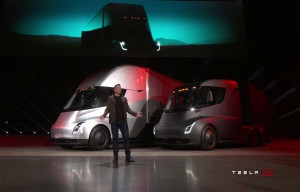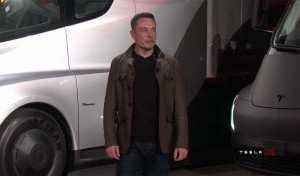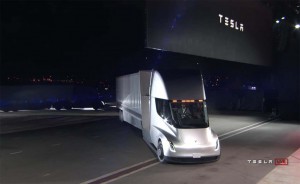Elon Musk’s mind-blowing, if oft-delayed semi-truck finally took center stage and if the numbers Tesla’s CEO tossed out are true, it’s a game changer.
“It blows my mind and I think it’ll blow yours,” he said after two models arrived as adoring Tesla fans screamed and shouted in delight.
The new truck, which features a dramatically designed cab that puts the driver in the center, will travel 500 miles on a single charge. This range comes with the truck fully loaded at 80,000 pounds, driving highway speeds, Musk noted. It also comes with a 1-million mile guarantee.
“This truck will not break down for 1 million miles,” Musk told the crown. Perhaps more importantly, he noted later, “We’re building it now.”
(Tesla’s big surprise: its gen-2 Roadster – and Musk promises it will be the “world’s fastest production car. Click Here for the mind-bending numbers.)
For a $5,000 deposit, potential truck owners can get in line for a truck that will come out some time in 2019, Musk said. He didn’t provide any production numbers or a hard delivery date, which is just as well since no Tesla has been delivered on time yet.
The truck’s performance is impressive. It can run zero to 60 mph in 5 seconds. If it’s fully loaded, it will make the run in 20 seconds. Conventional diesel trucks might as well be timed with a calendar.
Additionally, the Tesla semi can tackle at 5% grade at 65 mph compared with a diesel semi doing that at 45 mph fully laden.
(Musk promises to “blow your mind” with new electric truck. For the story, Click Here.)
The trucks can also recharge 30 minutes using a Tesla “megacharger,” which is the next step in the evolution of Tesla’s charging devices. He said truck owners will be able to use the chargers at no cost, in an agreement similar to Model S and Model X owners enjoy on the supercharger network.
The megachargers are a key component of the deal. While bragged about how fast and how far when it came to the semi, he didn’t say how much the truck costs. He did say that the trucks will be 20% cheaper per mile “from day one.”
The trucks can recharge for as little at 7 cents per kilowatt hour. If they use the charging system Musk promises to build, it gets very inexpensive because the chargers will be powered by solar energy, from panels built courtesy of another Musk company, SolarCity.
Current semis rely on a mishmosh of technology that comes from different suppliers, none of which is integrated and it consumes a lot of space in the cab, which can cause confusion and frustration. The Tesla semi takes all of this equipment and reduces it down to two simple touch screens sitting on each side of the steering wheel.
“You get everything from the time you get the truck,” he said.
(Click Here for more about an analyst ripping the Model 3 and its “shortcomings.”)
Musk said the trucks also get some autonomous vehicle technology as well. The trucks use lane-keeping technology as well as other tech to allow the driver to enjoy a level of self-driving abilty. There’s also a safety element to the system. If the driver becomes incapacitated, the truck will take over operation, bringing the truck slowly to a halt in its lane and call emergency services.

The new Tesla truck interior is simple and clean, eliminating the multitude of equipment that often litters the cab of current semi trucks.
Additionally, Tesla’s not alone in this game. A number of competitors are entering the clean truck segment. That includes Daimler AG, which owns five different truck brands, including U.S.-based Freightliner. It has just launched a medium-duty electric and has others in development. Volkswagen recently committed more than $1 billion for its own electric truck push.
A number of observers believe that the real market for battery freight-haulers will be in the medium-duty segment, rather than Semis, at least until extended-range batteries become available.
There are also several companies looking to market hydrogen-powered Semis. That includes Salt Lake start-up Nikola Motors, as well as Toyota, which recently began testing a fuel-cell truck at those LA ports. Hydrogen semis will be able to get as much as 1,000 miles on a tank, or so says Nikola, which would obviate the range issue. But the challenge will be finding the clean, lightweight gas.
(To see more about the reasons behind the semi-truck delays, Click Here.)
Currently, there are only a handful of hydrogen stations, most in California. Nikola has promised to set up its own distribution network, much like Tesla has done with its megacharger network.




“We’re building it now.”
Where? And why is this being focused on instead of sorting out the M3?
A reasonable question that we tried to address.
And the article says that it will come out sometime in 2019…?
2019 for the Semi, 2020 for the Roadster. Likely 2022 in reality. But we’ll see.
Paul E.